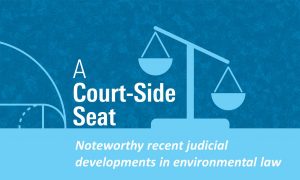Section 80201 of the Infrastructure Investment and Jobs Act of 2021, Public Law 117-58, reinstates the long-expired federal excise taxes that are imposed on specified chemical substances used in common industrial applications pursuant to Sections 4661 and 4671 of the Internal Revenue Code. The effective date of this reinstatement is July 1, 2022, and these taxes expire on December 31, 2031. The Act “decoupled” these reinstated chemical taxes from the now-expired Superfund petroleum excise tax that also funded the Superfund Hazardous Substance Response Trust Fund, which was created when Superfund (formally known as the Comprehensive Environmental Response Compensation and Liability Act, or CERCLA) was enacted in 1980. The Secretary of the Treasury was directed to publish an initial list of taxable chemicals by January 1, 2022, and this initial list was set forth in IRS Notice 2021-66. The list contains not only the 50 taxable chemical substances listed in Section 4672 (a)(3) of the Internal Revenue Code but also the 101 taxable chemicals listed in this Notice. In addition, Section 80201 of the Act also modified the existing tax rates by raising them.
Articles Posted in Environmental
Real Estate & Construction News Round-Up (05/11/22)
The supply of homes for sale is on the uptick, the White House releases a plan to improve the permitting process for infrastructure projects, cryptocurrency opens the door to a new class of property owners, and more.
Developments in Energy and Environmental Regulation: The View From Austin
Pillsbury’s Anne Idsal Austin moderated a Federal Bar Association (Houston Chapter) panel discussion with Erin Chancellor, Director of Legal Services at the Texas Commission on Environmental Quality (TCEQ), and Sam Gammage, General Counsel of the Texas Chemical Council (TCC), on Monday, April 18. The panelists brought to bear their regulatory, legislative, and legal expertise to discuss EPA’s increased emphasis on environmental justice (EJ) and Title VI, the TCEQ’s proposed compliance history rule, and the upcoming Sunset Review of the TCEQ
Real Estate & Construction News Round-Up 04/13/22
Phishing schemes target the mortgage industry, housing prices rise in Europe as Ukrainian refugees flee from their home country, the SEC announces new climate change regulations that will impact commercial real estate, and more.
NEPA’s Evolution During the Biden Administration
As our readers know, any construction project associated with a federal agency such as the Department of Transportation or Federal Transit Administration must comply with the requirements of the National Environmental Policy Act (NEPA). In Quicker But Less Dirty: The Biden Administration Both Streamlines and Seeks to Expand NEPA Environmental Review, written for the ABA Construction Forum’s Construction Lawyer journal, colleague Elaine Y. Lee provided a high-level overview of NEPA, its origins and current framework, criticisms, and prior administrations’ attempts to reform the law, before proceeding to examine two sets of changes to NEPA proposed by the Biden Administration that are arguably diametrically opposed.
Environmental and Regulatory Law Update: New Federal and State Rulings
The first quarter of 2022 has yielded a number of decisions, reversals and agency adjustments worth note.
FEDERAL CIRCUIT
U.S. Court of Appeals for the D.C. Circuit – Food & Water Watch v. Federal Energy Regulatory Commission
On March 11, 2022, the court decided the FERC case. On December 19, 2019, the Commission issued a Certificate to Tennessee Gas Pipeline and determined that a “modest expansion” and upgrade of the existing 11,000-mile natural gas pipeline would have no significant environmental impact. However, one of the Commissioners filed a partial dissent, arguing that the Commission’s treatment of the climate change impacts was inadequate. A petition for review was filed, and now the court has decided that the Commission erred in not accounting for the indirect effects of the expansion, namely the downstream emissions of greenhouse gas generated by the pipeline’s delivery of the gas to its customers. Consequently, NEPA’s requirement that a rigorous environmental assessment be made before the authorization was granted was violated. However, the court decided against vacating the Commission’s orders, which would have had a “disruptive effect” on the project which is, or soon will be, operational.
Real Estate & Construction News Round-Up 03/02/22
Economic sanctions placed on Russia cause a shift in the U.S. real estate market, investments in virtual real estate continue to grow as market equilibrium returns, climate change concerns have made a notable impact on regional real estate interest, and more.
A Court-Side Seat: Case Law Update (February 2022)
It is already early in 2022, but several important environmental cases have already been decided by the federal district and federal appellate courts.
Real Estate & Construction News Round-Up 02/09/22
A Florida home for sale offers a property deed via an NFT, nuclear power is projected to play an important role in the climate crisis, a Spanish real estate developer aims to set up an office in the the metaverse Decentraland, and more.
EPA Announces Increased Efforts to Require Cleanup of Coal Ash – Insurance Should Be a Component of Companies’ Response
On January 11, 2022, the U.S. Environmental Protection Agency (EPA) issued a press release announcing “key steps” it is taking to “protect groundwater from coal ash contamination.” Pillsbury attorney Matthew Jeweler recently authored the post, “EPA Announces Increased Efforts to Require Cleanup of Coal Ash – Insurance Should Be a Component of Companies’ Response,” discussing the insurance implications resulting from the Biden Administration’s new regulatory priorities. Continue Reading ›
 Gravel2Gavel Construction & Real Estate Law Blog
Gravel2Gavel Construction & Real Estate Law Blog



